Taxis and San Francisco Labor History
Article by Charles RathboneAll photographs are courtesy of the San Francisco History Center at the San Francisco Public Library
Unions have been a continuous presence in San Francisco's taxicab industry for more than one hundred years. This overview gives a sense of the waxing and waning of organized labor's ability to influence working conditions for drivers throughout the twentieth century. The information is drawn primarily from labor archives at San Francisco State University and from press accounts.
San Francisco "hackmen" had a union at least as early as 1904 when they lost a four month long strike that saw one picketer killed and strike breakers lured to grief by phony calls for service. Many drivers of taxicabs and rental limousines became union members during a successful 1909 organizing drive by the Chauffeurs' Union.
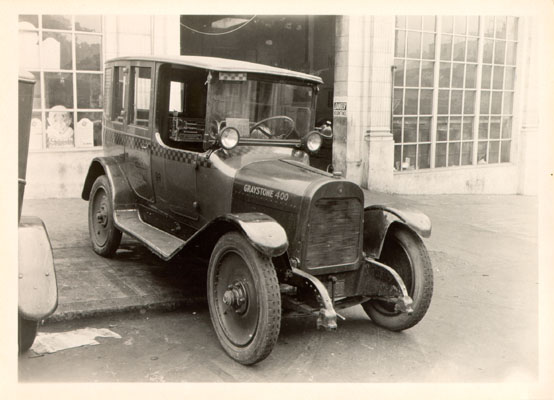
Checker Cab, 1926
There was a brief unsuccessful strike by 100 drivers in 1910 over union recognition. Rock-throwing strikers clashed with armed guards riding with strike breakers. The conflict resulted in an end to drivers paying for gasoline. By 1914 the union was demanding wages instead of payment by commission. In 1915 the last members of the Hackmens' Union transferred to the Teamster-affiliated Chauffeurs' Union Local 265.
There was a major organizing campaign in 1918. All but one company had signed contracts by the end of that year. The contracts increased daily wages and reduced the workday from ten hours to nine hours.
A strike in 1919 called for an eight-hour workday and increased wages. There was another strike in 1921, and a nine-month strike by 550 drivers in 1922 over a reduction in wages. By the mid-1920s, the last major cab company signed a union contract following a secret ballot by more than 400 drivers. Under the contract, drivers earned $4 a day plus a commission.

Desoto taxicab, 1930
Serious labor-management troubles erupted along the San Francisco waterfront during the 1930s and spread to the entire U.S. West Coast. Longshoremen sought increased wages, union recognition, and an end to favoritism and arbitrary firings. Employers, backed by police, resisted fiercely. A dramatic showdown in 1934 resulted in San Francisco police killing two strikers. The governor called in the National Guard, tanks rumbled along the waterfront and machine guns were mounted at the piers.
Four days after the killings, and on the sixty-first day of a coastwide shipping strike, more than ten thousand union members, their families and supporters marched eight and ten abreast in angry silence along San Francisco's Market Street to mourn the dead. A week later, virtually the entire city of San Francisco shut down as a general strike began. It lasted four days. On the eighty-second day of the waterfront strike, the longshoremans' union won all of its main demands.
Taxis were a constant presence along the waterfront in the thirties, with more than 400 trips a day coming from the frequent passenger ships. There was a taxi driver sympathy strike in the 1934 labor troubles, though some union drivers at Yellow Cab hauled strike breakers onto the docks during the general strike.
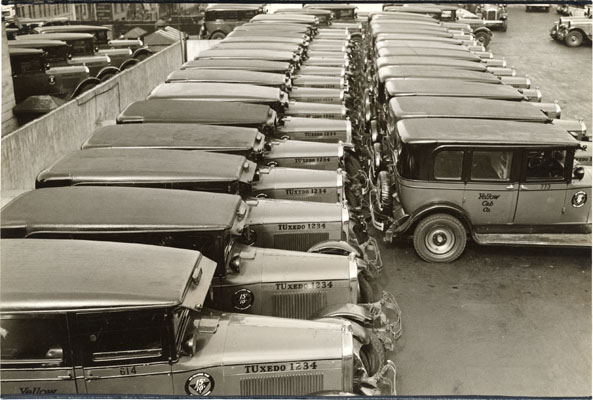
Yellow Cabs at 245 Turk Street idle during the general strike, 1934
Between 1934 and 1936, the drivers' union underwent a period of internal strife marked by beatings, shootings and the burning of vehicles. A key issue in those years was the hiring of large numbers of lackeys whom management could count on to vote for "stooge" union officers.
Taxi drivers were among the lowest paid union workers at this time. In 1936, cab drivers earned 38 cents an hour compared to 85-95 cents an hour for truck drivers and longshoremen. Even dishwashers earned 50 cents an hour. By the end of 1937, drivers had won a wage increase to $5 per day.
A sense of the spirit of the times can be gleaned from a passage in a January 1936 issue of The Taxi Worker. "San Francisco is well armed with cops, who if they did not spend all their time hunting for reds and butting into union officers, could watch for the cabs to see that they were not held up."
There was a dissident movement within the union in the 1940s, calling for democratic principles and an end to goon tactics.
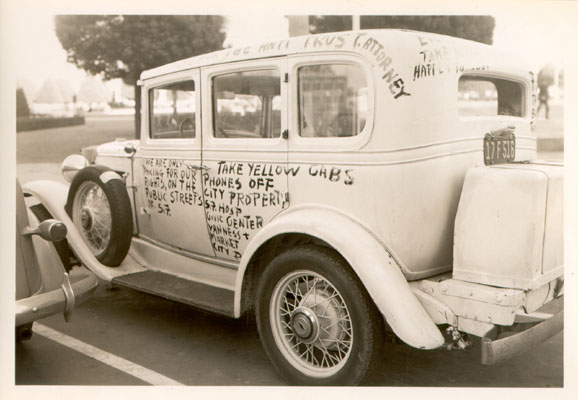
Taxicab with protest message across from City Hall, 1941
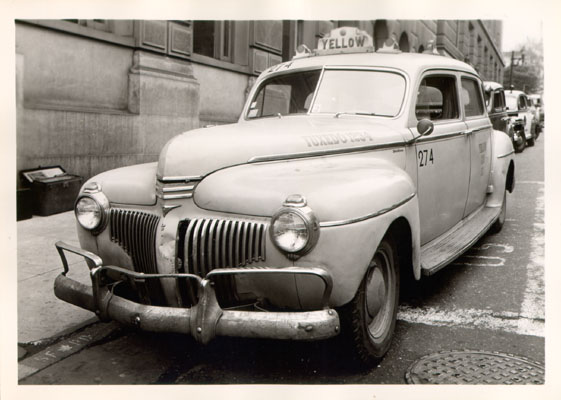
Yellow Cab Company taxicab, 1945
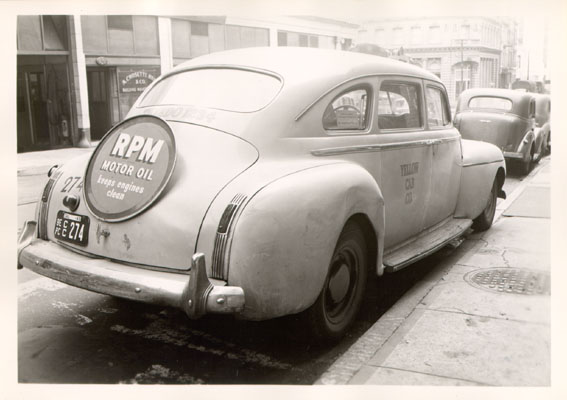
Yellow Cab Company taxicab, 1945
A one-day strike on January 1, 1947 led to a wage increase. The union won a 128-day taxi strike in 1948-49 that boosted wages from $9 per day or 49% of weekly receipts to $9.75 per day or 50% of receipts. During that strike, the employers' association disintegrated with one company settling early while another suffered heavy losses.
In the post-war era returning veterans lobbied for more taxi permits to be issued.

Veterans Cab handbill mid- or late 1940s, courtesy of Peg Schafer
Permit leasing become an issue as early as 1950, when the union urged an investigation into the practice. The union had fined three of its members for leasing their permits and working, in effect, as employers. The Police Commission investigated a real estate broker and former city permit official who leased permits to a cab company, but found no wrongdoing. Permit leases were about $145 a month and sale prices were about $8,000. The union challenged the practice again in 1959 when permits were sold for $16,000 each, and again in 1962 and 1963.
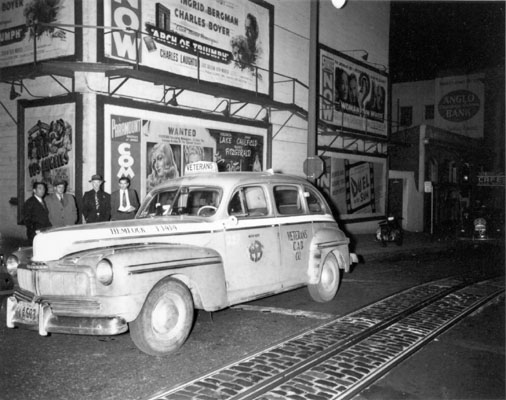
Veterans Cab at Golden Gate and Jones Streets, 1948
Racial discrimination was a key issue in the 1963 contract negotiations. At that time only one major cab company hired black drivers. At the urging of its black members, the union voted by a 10-1 margin to demand non-discrimination clauses in all of its contracts.
The 1963 negotiations sought a wage increase from $13 a day or half of the receipts to a flat wage of $16 per day. In 1967 a union official described local taxi contracts as the best in the nation, with drivers earning $13 a day plus tips or 50% of the fares, whichever was greater, plus health care and pension. By 1969, average full-time daily earnings were $18.70 plus $2 in tips.

Drivers returning to work at the end of a strike, 1949
Driver safety emerged as a key concern in 1969, but the issue was decided in the political arena instead of through contract negotiations. A law was passed requiring bullet-resistant partitions, but was suspended due to claims that 95% of drivers were opposed. In 1970, a vote was taken simultaneously with union elections. Drivers supported partitions by a vote of 588-522, but the law was repealed and no partitions were installed.
From 1970 on, leasing became an increasingly important labor issue in San Francisco. In 1973, union drivers at Luxor, DeSoto and Veterans paid flat rates of $20-22 per shift. A strike was averted when drivers voted 136-108 to accept a $2 increase in "gate" fees over a four month period.
By contrast, in 1972, drivers at Yellow worked under a contract that ensured an eight-hour workday and forty- hour week. Compensation was $16 per day or half of receipts, plus $54.50 per month for health and welfare benefits, plus $2.80 per day to the pension fund. Drivers had paid vacations of $100 a week for up to four weeks.

Harry Press and Milton Chorn in the front seat of a taxicab, 1948
All of Yellow's nearly 500 permits were held by the company. At Luxor and DeSoto, most permits were held by day drivers, while at Veterans and City, the permits were held mainly by absentees. The union drivers were those who worked nights at Luxor and DeSoto, and almost all of the drivers at Veterans and City. The permit- holder drivers were not affected by the union contracts.
By 1976, lease drivers at the four smaller companies were paying $25.50 to $27.50 per shift, while drivers at Yellow received paychecks of about $125 a week and reportedly earned about $35 in tips, as well as having a benefit package.
Throughout the seventies, there were a number of strikes or threatened strikes by union drivers operating under lease arrangements, the prime issue being non-negotiated increases in lease fees charged to drivers.
A major change in the San Francisco taxi industry occurred in 1976 due to criminal activities on the part of top management. The dominant operator, Yellow Cab, was owned by a conglomerate that included a failing bank. In 1976, the parent company collapsed, leading to criminal charges and prison for the CEO. Funds had been drained from subsidiary operations, including the cab company, in an effort to shore up the bank and an insurance company.
By April of 1976, the cab company was several months in arrears on payments into the drivers' benefit funds. When the total withheld from the pension fund exceeded one million dollars, the union sought legal recourse, resulting in attachment of the company's assets. The company shut down for eleven days, idling 500 cabs and 950 drivers. Yellow reopened under bankruptcy protection, but ceased operation for good in December 1976.
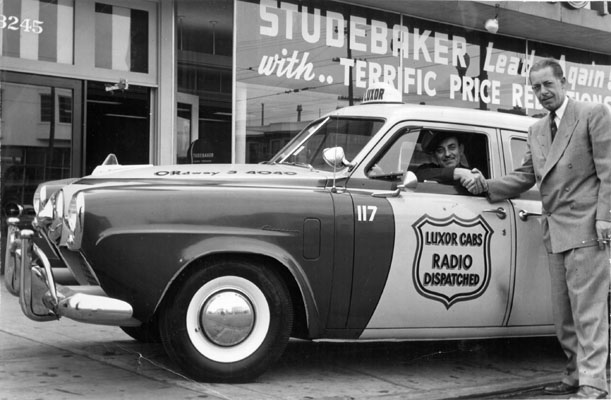
The first 1950 Aerodynamic Studebaker Champion taxicab in San Francisco, from Paramount Motors on Geary Street
A long period of legal wrangling over Yellow's permits ensued. The mayor refused to revoke and reissue the permits. A controversial deal to transfer permits was engineered by a partner in the mayor's law firm, but was widely criticized and eventually collapsed.
Permit speculation and the scent of political corruption prompted the Board of Supervisors to pass a measure barring the transfer of permits. Following a veto by the mayor, the matter was submitted to the voters and passed as Proposition K in 1978. "Prop K" grandfathered existing permits and requires that henceforth taxicab medallions can only be issued to drivers.
Eventually, after about a year of sparse cab service in San Francisco, a new Yellow Cab entity was formed. Drivers were offered a lopsided choice of employment arrangements resulting in a non-union leasing operation providing no benefit package for drivers. In 1979, a typical lease arrangement was $32 per shift with the driver paying an additional $13 for gasoline.

Mrs. Gilbert Gomez and Mrs. Carol Collins, Yellow Cab Company drivers, 1958
In 1980, union drivers at three smaller companies lost a showdown over open-shop practices. By the end of that year, non-union leasing was the exclusive employment arrangement for all San Francisco cab drivers with the exception of a relative handful at two companies. At least a few of these drivers continue to work under a Teamster contract to this day.
Grassroots organizing efforts contined into the 1980s especially regarding single issues and often galvanized by energetic individuals. Driver Andy Fahrenwald organized drivers around poor working conditions at the airport taxi staging lot. His wife Oliah Fahrenwald provided samples of written materials that Andy produced, including a letter to the mayor, another letter addressed to airport officials, a hand-drawn diagram of the staging area and a flyer urging drivers to action.
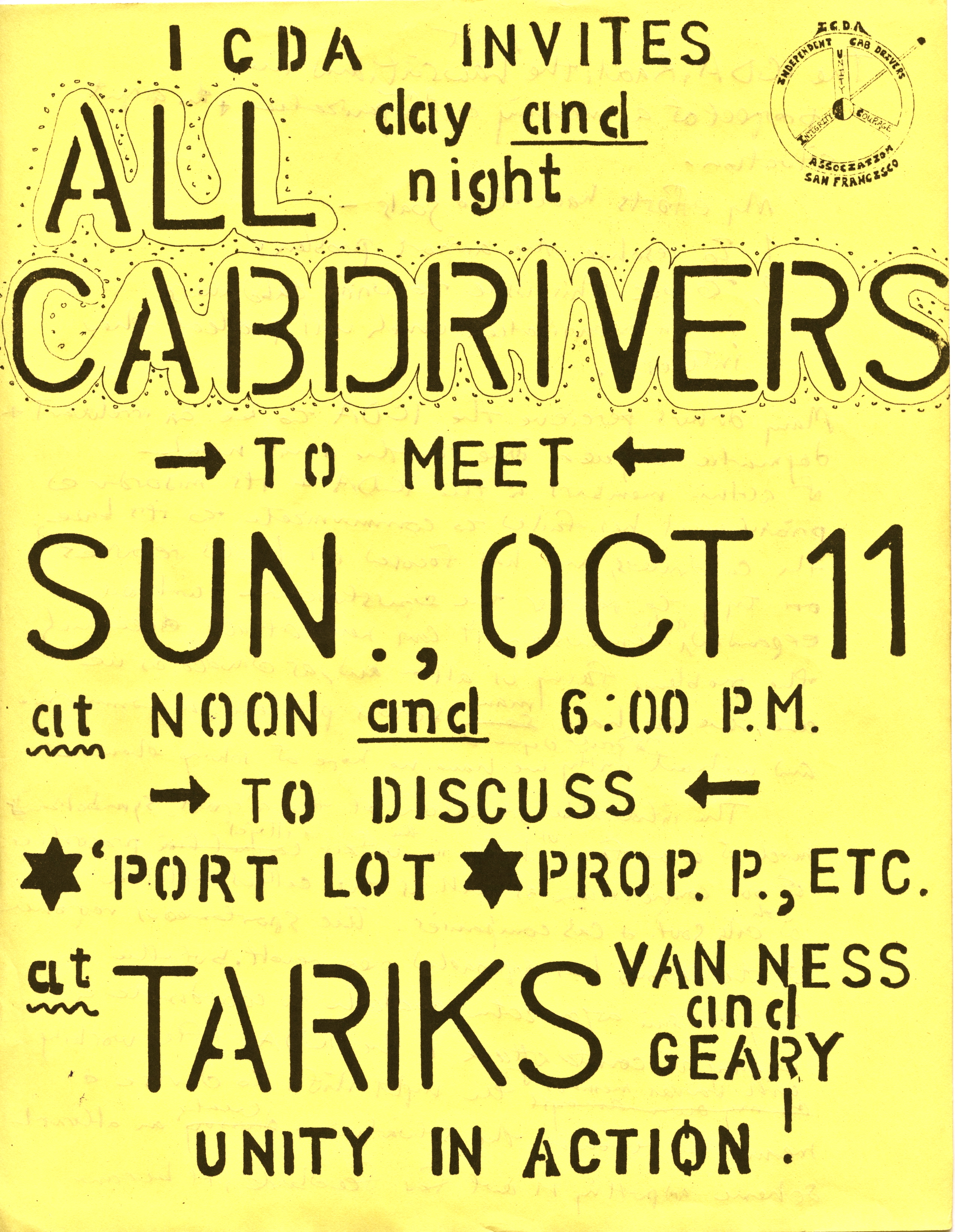
Flyer inviting drivers to a meeting of the Independent Cab Drivers' Association, probably 1981 - Courtesy of Oliah Fahrenwald
United Taxicab Workers (UTW), affiliated with Communications Workers of America Local 9410, has worked to organize drivers since the early 1980s. It twice filed for union elections, but the National Labor Relations Board ruled that the drivers were not employees. UTW lobbies for community and political support, a tactic common in the days before passage of the U.S. labor laws in the early 1900s.
In 1996, shift lease fees ranged from about $75 to $90 plus about $20 for gasoline. Drivers also paid a variety of formal and informal fees that, for many, amounted to $20 or more per shift. Additionally, drivers were charged upwards of $1000 in the event of accidental damage to cabs. Driver earnings varied widely, from possible negative amounts on the slowest days to more than $200 on the busiest nights.
Drivers with their own taxi medallions enjoyed substantially higher earnings. They could rent their cabs to other drivers for extra shifts, or could participate in a variety of cab company profit-sharing arrangements such as permit-leases or cooperatives.
The administration of Mayor Willie Brown brought a large expansion in the number of taxicab permits during the mid- and late-1990s. More than 600 drivers received their own taxi medallions, in many cases more than a dozen years after they had applied for the permits. By 2000, most taxi permits were in the hands of long-time cab drivers. The Permitholders and Drivers Association (PDA) was formed to represent their interests. The organization later changed its name to the Medallion Holders Association (MHA). Due to the long waiting time for permits, MHA members tend to be older drivers, while UTW members are generally younger drivers.
In 2006, shift lease fees averaged about $90 with a range from about $50 to $110 plus fuel. High fuel prices had led to the adoption of many fuel-efficient vehicles, though V-8 Ford Crown Victorias still comprised the majority of the fleet.
The history of the taxi industry in San Francisco goes well beyond what is found in labor archives. I would like to expand this section with material from business and personal archives as well. If you have a collection to share, or are an oldtimer who can fill in some of the gaps in this story, please use this mail link to contact me.
Versions of this article have appeared in Las Vegas Trip Sheet and in United to Win, the publication of United Taxicab Workers, San Francisco
For a look at more recent times, see photos from the 2003 protest at the SF Hilton.
[ Back to top ]
